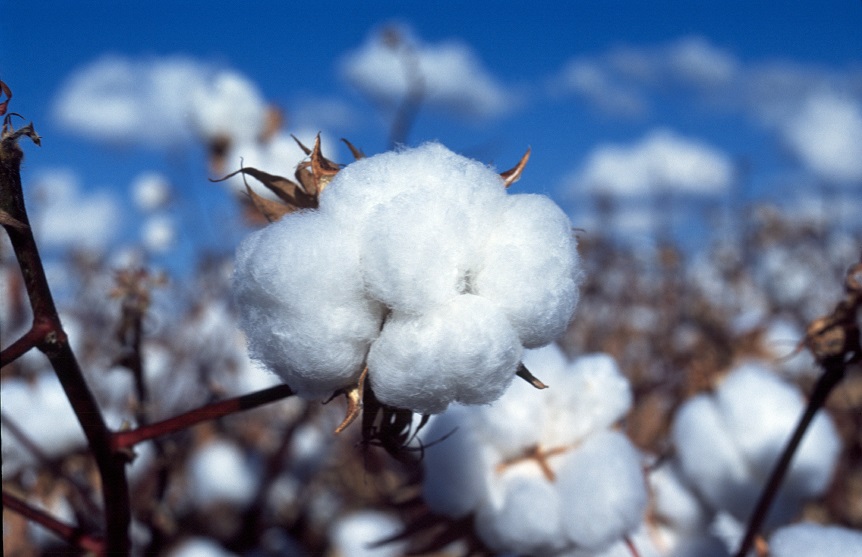
Cotton growing in bolls on the cotton plant
Each cotton fibre is an individual cell.
Imagine a shirt with the soft, natural feel of cotton that doesn’t need to be ironed. Or cotton woven pants that can stretch to give a better fit. This is the long-term goal of lead scientist Dr Filomena Pettolino and her team.
Nearly every cotton plant grown on Australian soil can trace its origins to one of our labs. Through our partnership with Cotton Seed Distributors, we’re proud to support the natural fibre industry. Australia has one of the biggest cotton crop yields in the world, however our cotton must now step up to be more competitive with the synthetic fibre market.
In 1995 synthetics constituted half of the global fibre market; in 2015 this figure was up to 77 per cent. The overall growth in the size of the fibre industry means that while the cotton market hasn’t shrunk, it also hasn’t increased a significant amount.
Synthetic fibres are cheaper to produce and require less maintenance, which has led to their widespread popularity. Since the invention of synthetic fibres, researchers have tried to make them more like natural fibres. In an attempt to take back the fibre market, researchers are now attempting to do the opposite — make cotton more like synthetics.

Researcher, Dr Danny Llewellyn, working with CSIRO's insect-resistant genetically modified cotton variety, Bollgard IIâ¢, in glasshouse.
We’re finally cottoning on to genes responsible for different fibre qualities
Bringing it back to basics
Dr Pettolino is taking cotton plant development back to the simple building blocks. To improve cotton fibres, first we have to understand what makes them the way they are. Each cotton fibre is an individual cell, so improving these cells relies on understanding what genes and external factors are responsible for different traits.
Fibre quality is determined by the length, strength, elongation, maturity (cell wall thickness) and fineness of each fibre. To improve these traits the researchers have to understand how cell wall composition, fibre genetics and fibre quality are related.
“If we can understand and control cell biology, we can understand fibre quality,” explains Dr Pettolino.
One of the ways the team is furthering this research is by studying traits they don’t want. ‘Shaun the Sheep’ is the affectionate name given to a particular strain of cotton fibre that is short and woolly — exactly what the researchers are trying to avoid. By identifying the reasons for these particular characteristics, scientists can better understand how to create strains without these traits.
This work is likely to have positive impacts that go beyond the cotton industry. Every time you wash your clothes, tiny microfibers of material are pulled free and enter our waterways. In the case of synthetic materials, this stays in the environment and can build up in the food chain. When you wash cotton clothing it also produces fibres, however these are biodegradable and will break down rapidly in the environment.
This season the first in a series of field trials will study whether changing fibre quality has an effect on yield.


18th September 2020 at 3:01 pm
Pipe dream. They should consult someone who knows something about textile fibres. Particularly the fundamental reasons why the various types of fibres have different properties.
During processing, it is already possible to improve the properties of cotton. Such as easy care, water repellancy, flame retardancy strechability etc.
17th January 2018 at 10:45 pm
Great idea, but the fibre quality is also determined by the growing conditions. My little cotton plants had a hard time with the heat, resulting in short woolly fibre. If our weather is too hot in the big cropping areas, then the plants will not achieve their genetic potential.
12th January 2018 at 3:23 pm
Will this new breed of cotton still require the enormous amounts of water that is being withheld by the industry preventing critical flows into the Murray/Darling basin?
Also what about the large amounts of environmentally damaging Glyphosate (N-(phosphonomethyl)glycine). Will that be reduced with this new breed? or will we continue to find Glyphosate (N-(phosphonomethyl)glycine in our water and food products due to its overuse?
10th January 2018 at 3:37 pm
*cannabis (damn you auto correct)
10th January 2018 at 3:35 pm
Is hemp being considered as a source of fibre to be developed by the CSIRO? Especially now in recent times that (some) politicians are relaxing their stance on all things cannibals, ie as medicine and food. I believe it is more environmentally friendly than cotton and produces a stronger fibre.